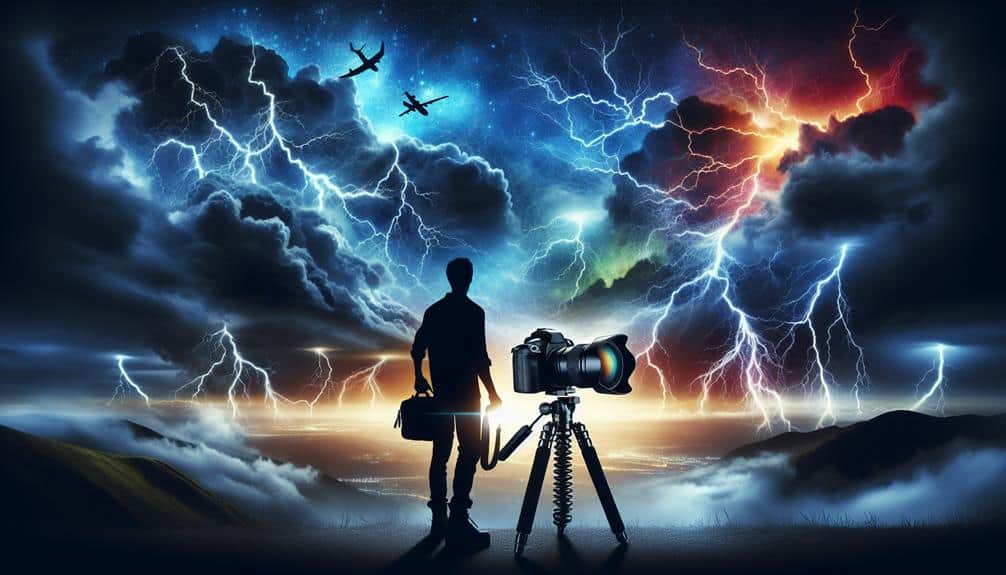Capturing lightning strikes on a smartphone is exciting when we have the appropriate tools and knowledge. First, we should select an app with manual exposure settings, slow shutter speeds, and burst mode. Next, let's adjust our camera to a low ISO (100-400) and a longer shutter speed (10-30 seconds) while focusing on infinity. Finally, staying safe by shooting from indoors and utilizing real-time weather apps ensures we're in the right place at the right time. Remember, using a tripod for stability can make all the difference. Stick with us for a deeper exploration into mastering this electrifying photography skill.
Key Points
- Use a dedicated camera app with manual exposure, burst mode, and slow shutter speeds.
- Set the ISO between 100-400 to avoid overexposure.
- Set the camera focus to infinity for capturing distant lightning strikes.
- Use a tripod to ensure stability and clear shots in low light.
Choose the Right App
Selecting the perfect app is important for capturing the fleeting brilliance of lightning strikes with your smartphone. We need tools that offer precision, reliability, and the right features to seize those electrifying moments.
First, let's delve into app features and comparison. Look for apps that offer manual exposure settings, burst mode, and slow shutter speeds. These functionalities are vital for capturing the exact moment lightning illuminates the sky.
Next, we move to user reviews and ratings. They provide invaluable insights into the app's real-world performance and reliability. We should prioritize apps with high ratings and positive feedback from users who've tested them in similar conditions. Reviews often highlight strengths and weaknesses we mightn't consider initially, like user interface intuitiveness or battery consumption during extended use.
We should also compare apps based on their unique features like live preview, night mode, and intervalometer settings. These can make a significant difference when dealing with unpredictable lightning strikes.
Optimize Camera Settings
Now that we've selected the ideal app, let's fine-tune our camera settings to maximize our chances of capturing that perfect lightning strike. Lightning photography requires a bit of finesse and some manual adjustments to guarantee our shots are striking and clear.
First, let's address the exposure settings. Lightning is a burst of intense light, so we should lower the ISO to diminish sensitivity to light, preventing overexposure. Aim for an ISO between 100-400.
Next, we'll adjust the shutter speed. A longer exposure time increases our chances of capturing a strike. Typically, a shutter speed around 10-30 seconds works well. However, if our app supports Bulb mode, we can keep the shutter open manually and close it once the lightning strikes.
Finally, we need to fine-tune the focus. Since lightning occurs at a distance, setting the focus to infinity guarantees sharpness. Most apps allow this manual adjustment, giving us control over the focus point.
Here's a quick recap:
- Lower ISO: Set between 100-400 to avoid overexposure.
- Longer Shutter Speed: Use 10-30 seconds or Bulb mode.
- Manual Focus: Set to infinity for distant clarity.
With these settings optimized, we're prepared to capture the awe-inspiring beauty of lightning.
Ensure Safety and Timing
Prioritizing our safety and timing is crucial when photographing lightning, as the unpredictability of storms demands both caution and precision. First and foremost, we should stay indoors. While the allure of capturing a perfect lightning strike might tempt us outside, the risk of being struck by lightning is too high. By staying indoors, we can utilize windows and covered areas to securely photograph the storm.
Monitoring weather conditions is another critical aspect. We need to keep a close eye on weather forecasts and real-time updates to anticipate the storm's arrival and intensity. Smartphone apps and websites provide minute-by-minute data, enabling us to plan our photography session around peak lightning activity. This guarantees we're prepared when the action begins and minimizes unnecessary exposure to danger.
Timing our shots is an art form in itself. Lightning is fleeting, so capturing it requires patience and skill. We can use the burst mode on our smartphones to take rapid sequences of photos, increasing our chances of catching a strike. Additionally, we can employ a tripod to stabilize our shots, guaranteeing sharpness and clarity even in low-light conditions.
Frequently Asked Questions
Can I Capture Lightning Strikes Without Using a Tripod?
We can capture lightning strikes without a tripod by mastering handheld techniques. Focus on lightning composition and steady your phone. For night photography, practice lightning safety—avoid exposed areas. Embrace creativity and freedom in your shots!
How Can I Protect My Phone From Water Damage During a Storm?
We can protect our phones from water damage during a storm by using waterproof cases. This guarantees we don't compromise our lightning photography techniques, allowing us the freedom to capture stunning shots without worrying about the rain.
Are There Any Post-Processing Tips for Enhancing Lightning Photos?
Ever wonder how we can make our lightning photos pop? Let's use lighting effects to amplify the drama and color correction to balance hues. These steps help transform our raw shots into electrifying masterpieces that captivate viewers.
Which Smartphone Models Are Best for Lightning Photography?
For the best smartphone models, we'd recommend those with advanced camera features like manual settings and long exposure modes. Utilizing these smartphone features and lightning photography techniques, we can capture stunning lightning strikes with artistic precision.
How Do I Avoid Blurry Lightning Photos?
Blurry lightning photos can be avoided by adjusting exposure settings and using burst mode. We can increase shutter speed and enable image stabilization for sharper shots. Let's capture the electrifying essence of lightning with precision and passion!


